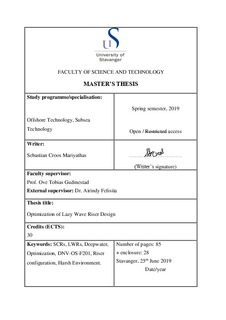| dc.contributor.advisor | Gudmestad, Ove Tobias | |
| dc.contributor.advisor | Felisita, Airindy | |
| dc.contributor.author | Mariyathas, Sebastian Croos | |
| dc.date.accessioned | 2019-10-09T08:17:20Z | |
| dc.date.available | 2019-10-09T08:17:20Z | |
| dc.date.issued | 2019-06-25 | |
| dc.identifier.uri | http://hdl.handle.net/11250/2621077 | |
| dc.description | Master's thesis in Offshore Technology : Subsea technology | nb_NO |
| dc.description.abstract | The objective of this thesis is to optimize the design of a Lazy Wave Riser (LWR) operating at different water depths and in different sea conditions. Design of lazy wave risers involves optimization of the various constituent parts and different parameters which improves the fatigue life and load capacity. The LWR is a concept that is introduced for deepwater applications and milder environmental conditions. The LWR design is well known for its improved fatigue life and feasibility of the operation.
The riser’s configurations are analyzed against extreme environmental conditions that occur on the Norwegian Continental Shelf (NCS) to study on the vulnerabilities of the riser. This study analyses the semi-submersible’s response to the combination of 100 years wave and 10 years of current and the worst conditions are determined by the maximum allowable utilization of the riser, which is less then unity and hence expresses a safe design. The bending moment and Von Mises stress at the critical sections, sag bend, hog bend and touch down point, are determined. These parameters are used in determining extreme response for the different configurations. Using the basic geometries and parameters, the riser design at different conditions and configurations are optimized using the Orcaflex software.
Four wave directions (0, 45, 90, 180 degrees) are considered as part of the sensitivity study, with a total of 132 combinations being were analyzed by Orcaflex. Furthermore, three different water depths were considered with the same set of parameters, tallying up to a grand total of 396 combinations of analyses. From the analysis results, it was found that the 180degree wave direction to the vessel is giving the maximum downward riser velocity. An increase in the bending moment along the sag-bend area often also contributes to compressive force at the touchdown region due to the associated forces. Overall, this thesis work shows that the response of a production Lazy Wave Riser optimized and designed for deployment in deep waters and harsh environment, is in compliance with the safe design criteria. | nb_NO |
| dc.language.iso | eng | nb_NO |
| dc.publisher | University of Stavanger, Norway | nb_NO |
| dc.relation.ispartofseries | Masteroppgave/UIS-TN-IMBM/2019; | |
| dc.subject | offshore teknologi | nb_NO |
| dc.subject | undervannsteknologi | nb_NO |
| dc.subject | deepwater | nb_NO |
| dc.title | Optimization of Lazy Wave Riser Design | nb_NO |
| dc.type | Master thesis | nb_NO |
| dc.subject.nsi | VDP::Technology: 500::Marine technology: 580::Offshore technology: 581 | nb_NO |
